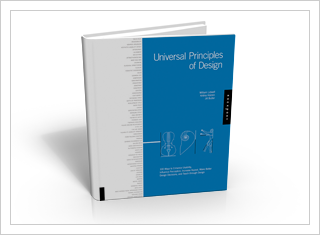
Universal Principles of Design it’s a quite recommendable book about design concepts in general: it doesn’t speak about software or product design only. In fact, it doesn’t even focus on design as much as the concepts that are hiding beneath the good designs, which are the main theme of the book.
Serving more as a reference than an introduction, it looks over 125 basic concepts than provide necessary support for many practices and techniques developed in this discipline.
Each of these concepts has an introduction, a brief explanation on its structure and how it affects the process or the result of the general product. It also includes a recommendation on how it should be applied to the production process.
Many of them follow tendencies and biological or cognitive human features, while the book also introduces references of studies, from which the conclusions are based on, and displays quick facts and brief versions of what those studies have to offer. They are intelligible and not too technical for those who are not involved in the field. The information presented is always brief and goes straight to the point.
In order to improve the way the concepts are introduced, each of them have associated examples, in which it is shown how the correct application can improve the design.
The concepts related to perception are the easiest to check — it only takes a look at the pictures to notice the effects they produce. Others require a little thinking but all of the examples include a test to demonstrate the point.
I have learned that this book has also turned into educational material for many teaching fields regarding the human-computer interaction. I am sure that this will be great educational material for other fields too.
All in all, this book is a great introductory reference, an essential key for a proper learning.
